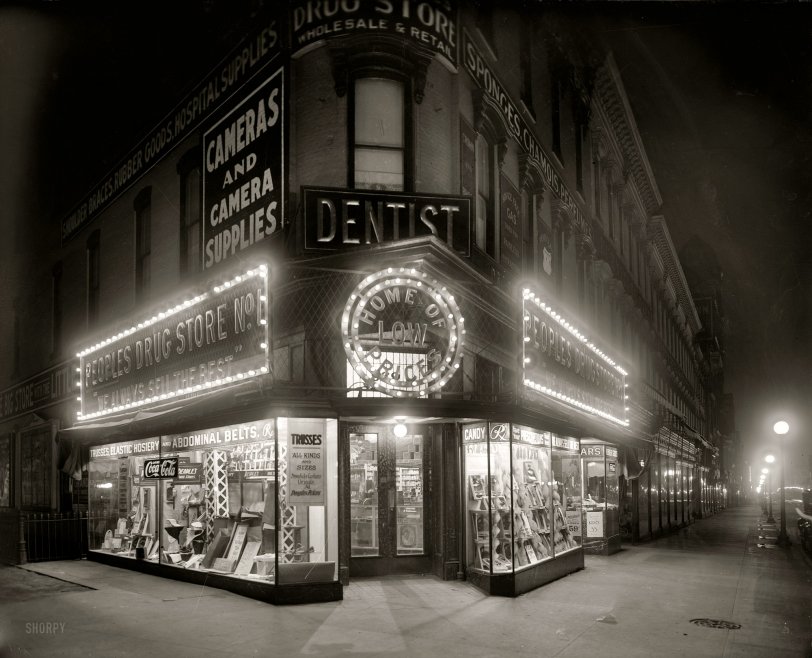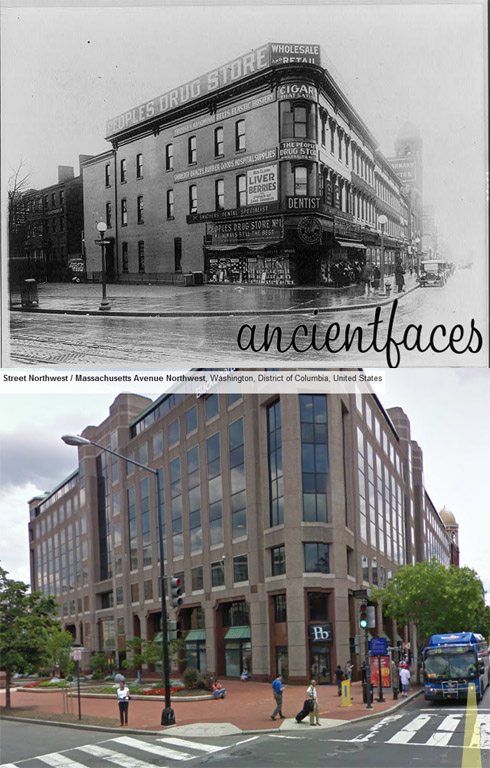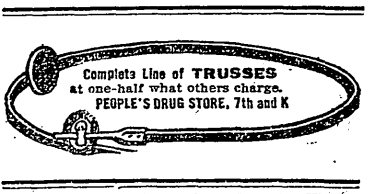


Framed or unframed, desk size to sofa size, printed by us in Arizona and Alabama since 2007. Explore now.
Shorpy is funded by you. Patreon contributors get an ad-free experience.
Learn more.

- Details, Details
- What's that building to the left of the tower?
- Coal Barges
- Bromo-Seltzer
- Inner harbor
- The Basin
- What a headache!
- Giant stepladder?
- Baldwin 62303
- Baldwin VO-1000
- Cold
- No expense spared
- Tough Guys
- Lost in Toyland
- And without gloves
- If I were a blindfolded time traveler
- Smoke Consumer Also Cooks
- Oh that stove!
- Possibly still there?
- What?!?
- $100 Reward
- Freeze Frame
- Texas Flyer wanted
- Just a Year Too Soon
- WWII -- Replacing men with women at the railroad crossing.
- Yes, Icing
- You kids drive me nuts!
- NOT An Easy Job
- I wonder
- Just add window boxes
Print Emporium
Pharm Noir: 1921

Washington, D.C., circa 1921. "People's Drug Store, Seventh & K, night." With a lurid display of "trusses and rubber goods." National Photo Co. View full size.
Not NPR, Blackboard
It's not at the NPR location. I kept thinking that the NPR location was oh so not the right angle. In this other image I found of the building, you can clearly see past it. It's on the other corner where the Blackboard building is. You can even see the tower down the street in both images.

Plurinal
Okay, so if I have one chamois, I say shammy. If I have two chamois, do I say shammys, or is it still shammy?
Also, does that sign say "Urinals"? Is that like a bedpan, or what?
Many buyers for trusses
Before the advent of antibiotics, many physical injuries that are now easily repaired by surgery were more safely left untreated, and the hard physical labors of working class people caused many to endure lifelong pain from chronic hernias, torn ligaments, compressed vertebrae and other painful conditions that were at least somewhat alleviated by trusses, supportive braces and wrappings. This might also explain the vast number of pain-relieving patent medicines and tonics. An elderly second-generation compounding pharmacist once told me that more than half of the proprietary products sold in his father's drugstore between 1912 and 1950 were either painkillers or laxatives, which were needed for another bad aspect of the Good Old Days, the overcooked and barely digestible food on many American tables.
Trusses
It seems that in every vintage photo of a drug store trusses were a major item. I never even hear about these things now. Why was there so much need for them back then?
Throughout the day...
I drive through the city searching out these gems posted here in hopes of them still standing. Too bad this wonderful architecture is now gone. This is a great night shot!
Rubber Goods
Hot water bottles were used to provide heat such as in bed on a cold night or heat to a particular area of the body: sore shoulder, toothache, etc. They were also used along with a "fountain syringe" to administer enemas. They have been replaced by heating pads, electric blankets and other heat generating devices, none of which are any good for giving enemas.
Trusses (as well as supportive underwear, belts and God only knows what else) provided support to herniated areas of the lower abdomen or other nether areas. The support ideally would prevent the hernia from becoming larger and prevent the necessity of surgery, which no one wanted to undergo in those days. These sorts of products are still sold, but perhaps not marketed quite as openly.
Am I that old?
I bought a new chamois just the other day -- your newfangled "cham-wow" just doesn't cut it drying off my 1953 MG TD! And as for what hot water bottles are used for, nothing keeps the feet warmer in polished cotton sheets on a winter night!
The Wonderful World of Rubber
That display on the right is a riot -- paper streamers decorating a window full of ... hot water bottles?!? Where is the sales appeal there? What did people even use hot water bottles for? America was evidently full of aches and pains and ruptures that required elastic fortification and heating.
Such was life, perhaps, without booze, Prozac and painkillers.
Chamois are great
for drying your car! I use one when I dry my car (I am very, VERY picky about my baby).
I LOVE the lights on this shop. What a great shot! Thanks, Dave.
Sham-Wow Chamois
ADVERTISING BLURBS ABOVE SECOND STORY WINDOWS:
"Shoulder Braces, Rubber Goods, Hospital Supplies . . "
"Sponges, Chamois, Perfumes . . ."
How often does one purchase a chamois today??
Looks like the dentist shared space with Der Komrades People's #1 Store. Considering he only has a second floor office, he merits a huge anonymous "DENTIST" sign. Next to the second floor window a lesser sign advertises "Advice Free. Gas used for Painless Extractions."
The pharmacy that time forgot
In the late 1960s some friends and I found an ancient Latino pharmacy in the oldest commercial section of Oakland, CA, the Botica Mundial. It still looked very much like this branch of People's Drug, and half of its street windows permanently featured an unusually lurid assortment of trusses, abdominal belts, braces, supports, and other items too mysterious or scary to mention. Many of these were displayed on painted plaster mannequin sections, torsos with groins, arms and legs, and a couple of heads. The dimly lit pharmacy interior smelled wonderful, as all real compounding pharmacies once did, and was jammed with dark wood cabinets and racks filled with both familiar products and others that seemed quite exotic. One whole section seemed to be devoted to Mexican magical potions and paraphernalia, and featured a rack of intensely floral perfumes with names like Noche de Pasión. A year or two after we found this place, it and its entire 1880s neighborhood were swept away by an especially harsh "urban renewal" project.
Ruptures II
"Joe, the counterman, encouraged customers to spill their guts."
Oh, Dave, you've outdone yourself. (It does make me wonder now about the mystery novels that had the victim trussed up in a chair, though.)
Complete Line of Trusses
Not being personally familiar with trusses, I have no idea how to interpret the following graphic:
And now it's...
NPR?
[Exactly. One-stop shopping for hot-water bottles, abdominal trusses and Nina Totenberg. - Dave]

























On Shorpy:
Today’s Top 5